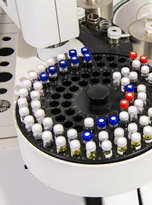Read and report vaccine reactions, harassment and failures.

The mumps virus was detected in 1934, and isolated in 1945; however it took researchers until 1948 to grow the virus in a laboratory setting. The first mumps vaccine, a killed virus vaccine, was developed for use in the United States in 1948. This vaccine, producing only short-term immunity, was available and used from 1950 until its discontinuation in 1978.
In 1963, vaccine researcher Maurice Hilleman used samples from his own daughter’s mumps case to isolate the mumps virus. This mumps strain, known as the Jeryl Lyn Strain named for his daughter, was used to create Mumpsvax, the first live mumps virus vaccine. Mumpsvax, manufactured by Merck, became available for use in the United States in 1967. In 1971, Mumpsvax was combined with the measles and rubella vaccine to become the MMR vaccine. Currently, mumps vaccine is only available in combination with measles and rubella (MMRII) and measles, rubella, and varicella (ProQuad). Both vaccines are manufactured by Merck.
In 1977, the CDC adopted its Advisory Committee on Immunization Practices’ (ACIP) recommendation for a single dose of mumps vaccine for all children at 12 months of age. However, in response to a resurgence of measles in the United States in 1989, the CDC updated its recommendation, recommending that two doses of a measles containing vaccine, preferably the MMR vaccine, be administered to all children. Recommendations were updated again in 1998 when the CDC recommended that the MMR vaccine be the vaccine of choice and for all fifty states to adopt vaccine legislation requiring that children receive two doses of MMR vaccine, after the age of 12 months, and at least one month apart, for school entry. At the time of this recommendation, the CDC’s ACIP did not consider the second dose of MMR vaccine to be a booster dose for mumps or rubella, reporting “a primary immune response to the first dose provides long-term protection.” They did, however, report that field studies on the mumps vaccine indicated an estimated vaccine effectiveness to be between 75 and 95 percent.
Mumps infections in the U.S. remained low until late 2005, when the Midwest experienced a large outbreak in a highly vaccinated population that included several college campuses. As a result of this outbreak, the CDC adopted the ACIP’s recommendation for two doses of mumps vaccine for school aged children and high-risk adults in May 2006. High-risk adults were defined as college students, health care providers, and international travelers. Mumps outbreaks continued to occur both in the United States as well as abroad.
In 2010, two former Merck employees filed a lawsuit alleging that Merck altered testing and study results to make the mumps vaccine appear more effective than it is in preventing mumps in children. The lawsuit, unsealed in 2012, also claimed that outbreaks in vaccinated populations were directly related to the falsification of the mumps efficacy data.
“Specifically, the suit claims Merck manipulated the results of clinical trials beginning in the late 1990s so as to be able to report that the combined mumps vaccine, known as MMR-II (a revised version of the 1971 MMR shot containing a different strain of the rubella virus), is 95 percent effective, in an effort to maintain its exclusive license to manufacture it. This percentage is the benchmark used by the FDA to grant Merck approval to sell its original mumps vaccine in 1967.”
Scientists involved in the whistleblower case claimed that Merck falsified vaccine efficacy testing by adding animal antibodies to the samples in order to demonstrate a vaccine effectiveness of 95 percent.
Merck denied all charges in connection with the lawsuit and stated:
"Merck has presented information that demonstrated to the United States Department of Justice that these allegations are factually false and after the department conducted its own two-year investigation, it decided not to pursue this lawsuit."
In 2015, Merck was accused by attorneys representing the scientists of stonewalling the case by stating that they are unable to perform current clinical trials of the mumps vaccine to determine current efficacy of the vaccine and instead provided the court with 50-year old efficacy data. Trial proceedings in the case were expected to begin in 2018, however, was delayed until late 2019.
In 2017, as a result of continued outbreaks in fully vaccinated populations, the CDC adopted the ACIP’s recommendation that a third dose of a mumps containing vaccine be administered in the event of an outbreak, stating:
“Current routine recommendation for 2 doses of MMR vaccine appears to be sufficient for mumps control in the general population, but insufficient for preventing mumps outbreaks in prolonged, close-contact settings, even where coverage with 2 doses of MMR vaccine is high.”
In June 2022, the FDA approved PRIORIX, a live attenuated measles, mumps, and rubella vaccine, manufactured by GlaxoSmithKline. PRIORIX was initially licensed in Germany in 1997 and according to the CDC, the vaccine has been in use globally in nearly 100 countries. On June 23, 2022, the CDC’s ACIP voted to approve use of PRIORIX as an option for the MMR vaccine according to the current MMR recommendations and off-label uses.
IMPORTANT NOTE: NVIC encourages you to become fully informed about Mumps and the Mumps vaccine by reading all sections in the Table of Contents, which contain many links and resources such as the manufacturer product information inserts, and to speak with one or more trusted health care professionals before making a vaccination decision for yourself or your child. This information is for educational purposes only and is not intended as medical advice.



